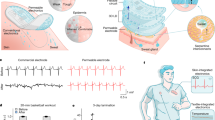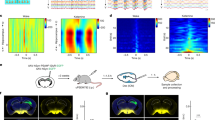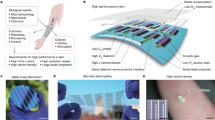Abstract
Endocochlear potential (EP) is a battery-like electrochemical gradient found in and actively maintained by the inner ear1,2. Here we demonstrate that the mammalian EP can be used as a power source for electronic devices. We achieved this by designing an anatomically sized, ultra-low quiescent-power energy harvester chip integrated with a wireless sensor capable of monitoring the EP itself. Although other forms of in vivo energy harvesting have been described in lower organisms3,4,5, and thermoelectric6, piezoelectric7 and biofuel8,9 devices are promising for mammalian applications, there have been few, if any, in vivo demonstrations in the vicinity of the ear, eye and brain. In this work, the chip extracted a minimum of 1.12 nW from the EP of a guinea pig for up to 5 h, enabling a 2.4 GHz radio to transmit measurement of the EP every 40–360 s. With future optimization of electrode design, we envision using the biologic battery in the inner ear to power chemical and molecular sensors, or drug-delivery actuators for diagnosis and therapy of hearing loss and other disorders.
This is a preview of subscription content, access via your institution
Access options
Subscribe to this journal
Receive 12 print issues and online access
$209.00 per year
only $17.42 per issue
Buy this article
- Purchase on Springer Link
- Instant access to full article PDF
Prices may be subject to local taxes which are calculated during checkout



Similar content being viewed by others
References
Von Bekesy, G. Resting potentials inside the cochlear partition of the guinea pig. Nature 169, 241–242 (1952).
Hibino, H., Nin, F., Tsuzuki, C. & Kurachi, Y. How is the highly positive endocochlear potential formed? The specific architecture of the stria vascularis and the roles of the ion-transport apparatus. Pflügers Arch. 459, 521–533 (2010).
Himes, C., Carlson, E., Ricchiuti, R.J., Otis, B.P. & Parviz, B.A. Ultralow voltage nanoelectronics powered directly, and solely, from a tree. IEEE Trans. NanoTechnol. 9, 2–5 (2010).
Rasmussen, M., Ritzmann, R.E., Lee, I., Pollack, A.J. & Scherson, D. An implantable biofuel cell for a live insect. J. Am. Chem. Soc. 134, 1458–1460 (2012).
Halámková, L. et al. Implanted biofuel cell operating in a living snail. J. Am. Chem. Soc. 134, 5040–5043 (2012).
Hochbaum, A.I. et al. Enhanced thermoelectric performance of rough silicon nanowires. Nature 451, 163–167 (2008).
Qin, Y., Wang, X. & Wang, Z.L. Microfibre–nanowire hybrid structure for energy scavenging. Nature 451, 809–813 (2008).
Chaudhuri, S.K. & Lovley, D.R. Electricity generation by direct oxidation of glucose in mediatorless microbial fuel cells. Nat. Biotechnol. 21, 1229–1232 (2003).
Rapoport, B.I., Kedzierski, J.T. & Sarpeshkar, R. A glucose fuel cell for implantable brain-machine interfaces. PLoS One 7, e38436 (2012.
Starner, T. & Paradiso, J.A. Human-generated power for mobile electronics. in Low Power Electronics Design (ed. Piquet, C.) 1–35 (CRC Press, 2004).
Donelan, J.M. et al. Biomechanical energy harvesting: generating electricity during walking with minimal user effort. Science 319, 807–810 (2008).
Bullen, R.A., Arnot, T.C., Lakeman, J.B. & Walsh, F.C. Biofuel cells and their development. Biosens. Bioelectron. 21, 2015–2045 (2006).
Dallos, P. Some electrical circuit properties of the organ of Corti. I. Analysis without reactive elements. Hear. Res. 12, 89–119 (1983).
Takeuchi, S., Ando, M. & Kakigi, A. Mechanism generating endocochlear potential: role played by intermediate cells in stria vascularis. Biophys. J. 79, 2572–2582 (2000).
Lang, H., Schulte, B.A. & Schmiedt, R.A. Endocochlear potentials and compound action potential recovery: functions in the C57BL/6J mouse. Hear. Res. 172, 118–126 (2002).
Zidanic, M. & Brownell, W.E. Fine structure of the intracochlear potential field. I. The silent current. Biophys. J. 57, 1253–1268 (1990).
Fernandez, C. Dimensions of the cochlea (guinea pig). J. Acoust. Soc. Am. 24, 519–523 (1952).
Swanson, R.M. & Meindl, J.D. Ion-implanted complementary MOS transistors in low-voltage circuits. IEEE ISSCC Dig. Tech. Papers 192–193 (1972).
Chen, P.-H. et al. A 95mV-startup step-up converter with VTH-tuned oscillator by fixed-charge programming and capacitor pass-on scheme. IEEE ISSCC Dig. Tech. Papers 216–217 (2011).
Ramadass, Y.K. & Chandrakasan, A.P. A battery-less thermoelectric energy harvesting interface circuit with 35mV startup voltage. IEEE J. Solid-State Circuits 46, 333–341 (2011).
Shimamura, T. et al. Nano-watt power management and vibration sensing on a dust-size batteryless sensor node for ambient intelligence applications. IEEE ISSCC Dig. Tech. Papers 540–541 (2010).
Wieckowski, M., Chen, G.K., Seok, M., Blaauw, D. & Sylvester, D.D. A hybrid DC-DC converter for sub-microwatt sub-1V implantable applications. IEEE Symposium on VLSI Circuits 166–167 (2009).
Zhang, F. et al. A batteryless 19uW MICS/ISM-band energy harvesting body area sensor node SoC. IEEE ISSCC Dig. Tech. Papers 298–299 (2012).
Roy, K., Mukhopadhyay, S. & Mahmoodi-Meimand, H. Leakage current mechanisms and reduction techniques in deep-submicrometer CMOS circuits. Proc. IEEE 91, 305–327 (2003).
Chen, G. et al. A cubic-millimeter energy-autonomous wireless intraocular pressure monitor. IEEE ISSCC Dig. Tech. Papers, 310–311 (2011).
Chow, E.Y., Chlebowski, A.L. & Irazoqui, P.P. Mixed-signal integrated circuits for self-contained sub-cubic millimeter biomedical implants. IEEE Trans. BioCAS 4, 340–349 (2010).
Mason, M.J. Middle ear structures in fossorial mammals: comparison with non-fossorial species. J. Zool. (Lond.) 255, 467–486 (2001).
Mills, D.M., Norton, S.J. & Rubel, E.W. Vulnerability and adaptation of distortion product otoacoustic emissions to endocochlear potential variation. J. Acoust. Soc. Am. 94, 2108–2122 (1993).
Von Bekesy, G. DC resting potentials inside the cochlear partition. J. Acoust. Soc. Am. 24, 72–76 (1952).
Fayad, J.N., Semaan, M.T., Meier, J.C. & House, J.W. Hearing results using the Smart piston prosthesis. Otol. Neurotol. 30, 1122–1127 (2009).
Mowry, S.E., Woodson, E. & Gantz, B.J. New frontiers in cochlear implantation: acoustic plus electric hearing, hearing preservation, and more. Otolaryngol. Clin. North Am. 45, 187–203 (2012).
Acknowledgements
We acknowledge support from the C2S2 Focus Center and the Interconnect Focus Center, two of six research centers funded under the Focus Center Research Program (FCRP), a Semiconductor Research Corporation entity (A.P.C., P.P.M., S.B.), and from US National Institutes of Health grants K08 DC010419 (K.M.S.) and T32 DC00038 (A.C.L.) and the Bertarelli Foundation (K.M.S.). We thank J.J. Guinan Jr. for experimental assistance and advice, and B. Zhu for preliminary studies.
Author information
Authors and Affiliations
Contributions
A.P.C. and K.M.S. conceived the project. P.P.M., A.C.L., S.B., A.P.C. and K.M.S. designed experiments. P.P.M., A.C.L. and S.B. performed the experiments. P.P.M. and S.B. designed and implemented the electronic chip. A.C.L. performed the EP measurements. P.P.M., A.C.L., S.B., A.P.C. and K.M.S. wrote and edited the manuscript.
Corresponding authors
Ethics declarations
Competing interests
The authors declare no competing financial interests.
Supplementary information
Supplementary Text and Figures
Supplementary Figures 1–3 (PDF 125 kb)
Rights and permissions
About this article
Cite this article
Mercier, P., Lysaght, A., Bandyopadhyay, S. et al. Energy extraction from the biologic battery in the inner ear. Nat Biotechnol 30, 1240–1243 (2012). https://doi.org/10.1038/nbt.2394
Received:
Accepted:
Published:
Issue Date:
DOI: https://doi.org/10.1038/nbt.2394
This article is cited by
-
Wireless and battery-free technologies for neuroengineering
Nature Biomedical Engineering (2021)
-
Self-powered cardiovascular electronic devices and systems
Nature Reviews Cardiology (2021)
-
A self-powered analog sensor-data-logging device based on Fowler-Nordheim dynamical systems
Nature Communications (2020)
-
Symbiotic cardiac pacemaker
Nature Communications (2019)
-
Potential Power Supply Methods for Implanted Devices
Biomedical Engineering (2018)



